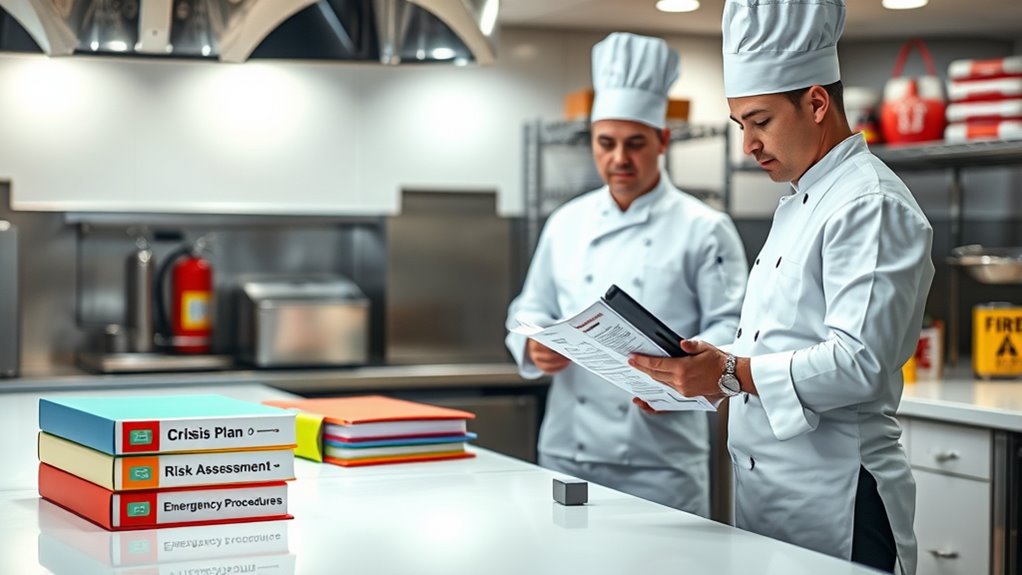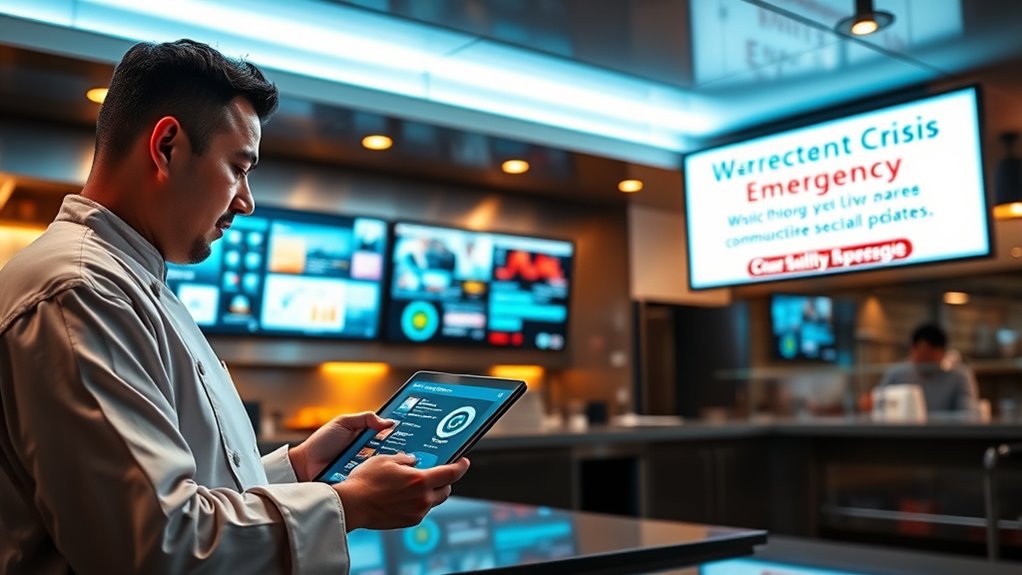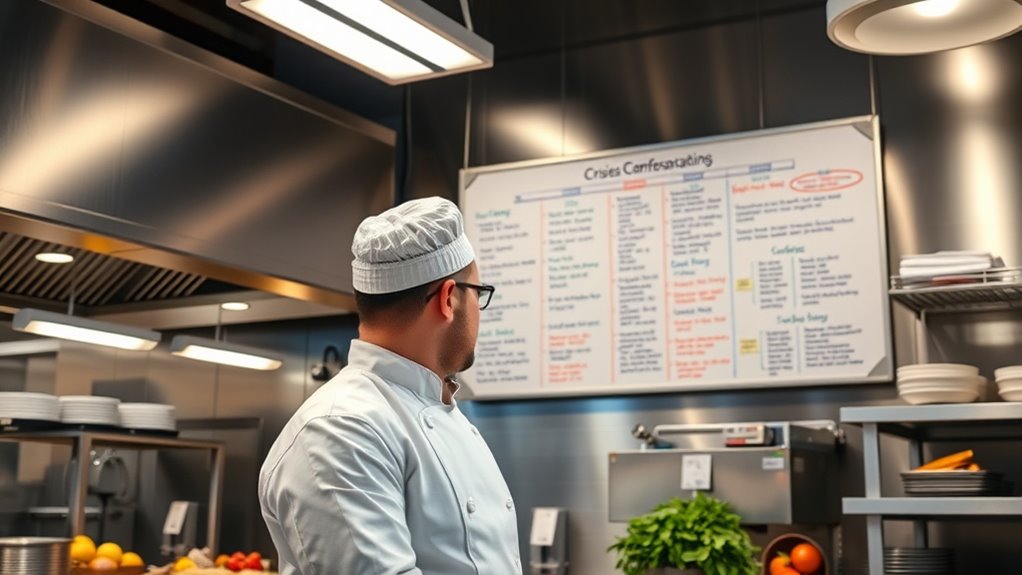To create an effective crisis communication plan for your restaurant, start by identifying potential risks and preparing responses in advance. Assign clear roles, including a primary spokesperson, and develop consistent messaging that’s honest, simple, and empathetic. Leverage social media and digital tools for real-time updates, and train staff regularly on crisis protocols. Regularly review and update your plan to guarantee you’re ready, and discover how to implement these strategies smoothly and effectively.
Key Takeaways
- Identify potential crises and establish clear roles, including a designated spokesperson and communication hierarchy.
- Develop pre-drafted messages for common emergencies to enable rapid, consistent responses.
- Use digital channels like social media, websites, and email alerts for real-time updates and transparency.
- Craft simple, honest, and empathetic messages to maintain trust and reduce misinformation during crises.
- Regularly train staff through drills and review plans to ensure preparedness and effective crisis management.
Assessing Potential Risks and Preparing in Advance

To effectively handle crises, you must start by identifying potential risks that could impact your restaurant. Begin by analyzing your operations, location, and customer base to spot vulnerabilities. Consider natural disasters, health emergencies, food safety issues, and staffing shortages. Conduct a thorough risk assessment, ranking threats by likelihood and impact. This proactive approach helps you prioritize preparation efforts. Develop contingency plans for each identified risk, including communication strategies, resource allocation, and response procedures. Regularly review and update your risk assessments to stay ahead of emerging threats. Incorporating specialized planning tools can further enhance your preparedness. By understanding potential hazards and preparing in advance, you ensure your team is ready to respond swiftly and effectively, minimizing damage and maintaining customer trust during crises.
Developing Clear and Consistent Messaging

You need to craft key messages that clearly communicate your restaurant’s response during a crisis. Ensuring message uniformity across all channels helps build trust and prevents confusion. Focus on consistency and clarity to effectively guide your staff and customers through challenging situations. Incorporating best practices from proven communication strategies can further enhance the effectiveness of your plan.
Crafting Key Messages
Crafting key messages is essential to guarantee your restaurant communicates clearly and maintains trust during a crisis. Your messages should be straightforward, honest, and focused on what your audience needs to know. Start by identifying the core facts—what happened, how you’re responding, and what customers should do. Use simple language and avoid technical jargon to ensure everyone understands. Keep your tone calm and empathetic, showing you care about your community’s safety and well-being. Repeating your main points helps reinforce your message and reduces confusion. Remember, your goal is to provide reassurance and accurate information without causing panic. Clear, concise messaging builds credibility and demonstrates your commitment to transparency during challenging times. Incorporating consistent messaging ensures your communication remains reliable and trustworthy throughout the crisis.
Ensuring Message Uniformity
Ensuring message uniformity is essential for maintaining trust and clarity during a crisis. When your team delivers consistent messages, customers feel reassured and confident in your response. To achieve this, everyone involved must understand and follow your key messages. Use a communication plan that clearly defines your core messages, tone, and channels. Visualize this with a simple table:
| Audience | Message Focus | Channel |
|---|---|---|
| Customers | Safety measures | Social media |
| Staff | Emergency protocols | Staff meetings |
| Media | Company stance | Press releases |
This table helps align your messaging across all touchpoints, preventing confusion. Consistent messaging reinforces your credibility, minimizes misinformation, and demonstrates your professionalism during challenging times. Additionally, regularly updating and reviewing your communication plan ensures it remains effective and adaptable to evolving situations, which is vital for effective crisis communication during unexpected events.
Designating Crisis Communication Roles and Responsibilities

To respond effectively during a crisis, restaurants must clearly assign communication roles and responsibilities beforehand. You should designate a primary spokesperson responsible for delivering key messages and maintaining consistency. Identify team members who will handle media inquiries, social media updates, and internal communication. Make sure each person understands their specific tasks and authority limits. It’s vital to establish a chain of command so decisions are made swiftly and efficiently. Training staff on their roles ensures everyone knows what to do under pressure. Clearly defined responsibilities prevent confusion, reduce delays, and help maintain message uniformity. This clarity allows your team to act confidently and cohesively, minimizing misinformation and protecting your restaurant’s reputation during a crisis. Additionally, understanding best practices for communication can further enhance your preparedness and response effectiveness.
Leveraging Digital Channels for Real-Time Updates

Leveraging digital channels for real-time updates allows your restaurant to communicate quickly and effectively during a crisis. By using platforms like social media, your website, and email alerts, you can provide immediate information to customers, staff, and stakeholders. This guarantees everyone stays informed about closures, safety measures, or changes in operations. This is especially important when coordinating retail hours, which may be affected during emergencies. Keeping messages clear and consistent is vital to prevent confusion and rumors. Regular updates build trust and demonstrate transparency, showing you’re actively managing the situation. Utilize scheduling tools or social media management platforms to streamline your communication process. Remember, timing is key—delivering timely updates can minimize panic and maintain your restaurant’s reputation during challenging times. Digital channels are essential tools for managing your crisis response in today’s fast-paced environment.
Training Staff on Crisis Response Procedures

Effective crisis communication relies heavily on well-prepared staff who know how to respond quickly and appropriately. You need to train your team on clear procedures for various emergencies, from health issues to safety threats. Conduct regular drills to reinforce responses and identify gaps. Make sure everyone understands their roles and communication protocols during a crisis. Use practical scenarios to simulate real situations, boosting confidence and coordination. Here’s a quick overview:
| Situation | Staff Responsibilities | Key Communication Tools |
|---|---|---|
| Medical Emergency | Assist injured, alert emergency | Phone, PA system |
| Fire or Evacuation | Guide guests to exits | Walkie-talkies, alarms |
| Negative Publicity | Provide accurate info, stay calm | Social media, staff briefings |
| Understanding Hydrocolloid technology and its role in healing can help staff better explain treatments to customers when needed.
Reviewing and Updating the Plan Regularly

Regularly reviewing and updating your crisis communication plan guarantees it remains relevant and effective. You should schedule formal reviews at least once a year, or after any incident. During these reviews, consider:
- Evaluating what worked and what didn’t during past crises
- Incorporating new potential threats or challenges
- Updating contact information for team members and external partners
- Refining communication strategies based on recent feedback
- Assessing the plan’s compatibility with advanced communication technology to ensure optimal response capabilities
Frequently Asked Questions
How Can Small Restaurants Customize Their Crisis Communication Plans Effectively?
You can customize your crisis communication plan by first identifying potential risks specific to your restaurant. Then, develop clear, concise messages tailored to your audience, including staff and customers. Use multiple channels like social media and emails to guarantee your message reaches everyone promptly. Regularly train your team on procedures, update your plan based on new challenges, and practice simulations to stay prepared for any crisis.
What Are the Costs Associated With Implementing a Comprehensive Crisis Communication Strategy?
When you implement a thorough crisis communication strategy, you’ll face costs like staff training, developing materials, and potential technology investments. You might also spend on consulting or expert advice to craft your plan. While these expenses can seem high initially, they’re investments that protect your business reputation, minimize damage, and guarantee swift recovery during crises. Ultimately, the costs are balanced by the peace of mind and resilience you gain.
How Do Cultural Differences Influence Crisis Messaging in Diverse Restaurant Environments?
Cultural differences shape how your audience perceives and responds to crisis messages. You need to tailor your communication to respect local customs, language nuances, and values. When you understand cultural sensitivities, your messages become more effective and build trust. You should avoid stereotypes and seek input from diverse team members to craft respectful, clear, and culturally appropriate responses that resonate and reassure your diverse restaurant patrons during crises.
What Legal Considerations Should Be Included in the Crisis Communication Plan?
Imagine you’re in 2023, steering through a digital age where legal pitfalls are like landmines. You should include a clear outline of confidentiality obligations, ensuring sensitive information stays private. Also, consider defamation laws to prevent false statements, and include procedures for responding to legal claims swiftly. By doing so, you protect your reputation and avoid costly lawsuits, making your crisis response both responsible and effective.
How Can Restaurants Measure the Success of Their Crisis Communication Efforts?
You can measure your crisis communication efforts by tracking key metrics like social media engagement, media coverage, and customer feedback. Monitor changes in customer sentiment through surveys and review responses promptly. Analyzing response time and transparency also helps gauge effectiveness. Additionally, compare pre- and post-crisis sales or reservation data. These indicators help you assess whether your communication strategies restore trust and maintain your restaurant’s reputation.
Conclusion
By preparing a solid crisis communication plan, you’re building a sturdy shield to protect your restaurant’s reputation. When challenges strike, your clear messaging and trained team will act like a well-oiled machine, steering you through turbulent waters. Keep your plan updated and leverage digital channels to stay connected. Remember, a proactive approach is your lighthouse, guiding you safely ashore no matter how stormy the seas get.









